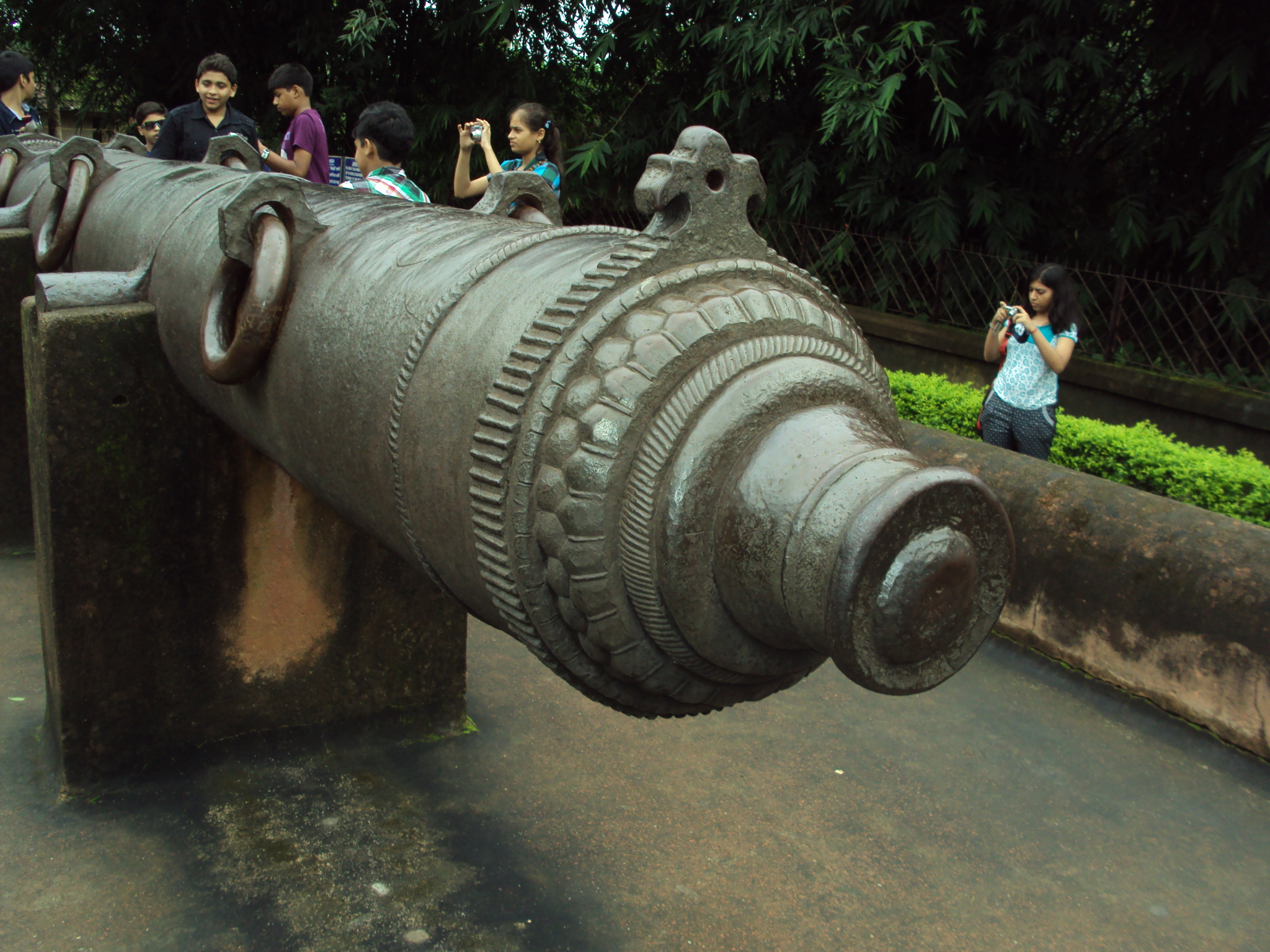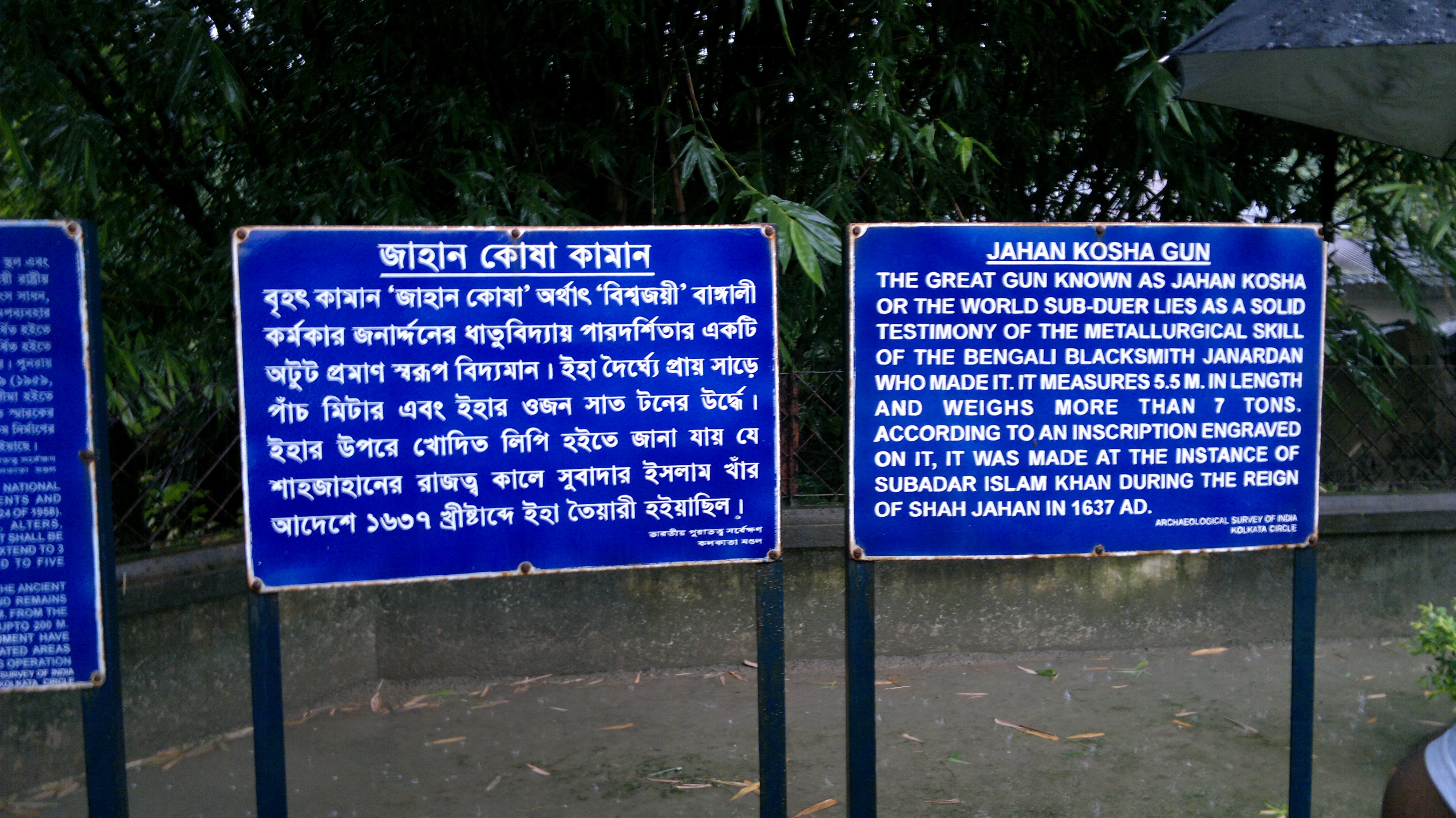Jahan Kosha Cannon on:
[Wikipedia]
[Google]
[Amazon]
 Jahan Kosha Cannon (also known as the Great Gun, and
Jahan Kosha Cannon (also known as the Great Gun, and  The cannon is more than 7 tons in weight. It is 17 feet and 6 inches in length and 3 feet in width. It has a girth of 5 feet at the touch hole end. The circumference of its mouth is more than one foot. The radius of the touch hole is one and a half inches. In order to fire this cannon once, 17 kilograms of gunpowder was needed. The bore is approximately 6 inches.
The cannon is more than 7 tons in weight. It is 17 feet and 6 inches in length and 3 feet in width. It has a girth of 5 feet at the touch hole end. The circumference of its mouth is more than one foot. The radius of the touch hole is one and a half inches. In order to fire this cannon once, 17 kilograms of gunpowder was needed. The bore is approximately 6 inches.

 The cannon was made in 1637 by Janardan Karmakar, a blacksmith and gunsmith, under the instructions of Daroga Shere Mohammad and under the supervision of Hara Ballav Das. The cannon was made in
The cannon was made in 1637 by Janardan Karmakar, a blacksmith and gunsmith, under the instructions of Daroga Shere Mohammad and under the supervision of Hara Ballav Das. The cannon was made in
literally
''Literally'' is an English adverb. It has been controversially used as an intensifier for figurative statements.
History
The first known use of the word ''literally'' was in the 15th century, or the 1530s, when it was used in the sense of "in ...
means the ''Destroyer of the World'') is placed in the ''Topekhana'', 400 m to the south east of the Katra Mosque
The Katra Masjid is a former caravanserai, mosque and the tomb of Nawab Murshid Quli Khan. It was built between 1723 and 1724. It is one of the largest caravanserais in the Indian subcontinent. It was built during the 18th century, when the ea ...
, in the town of Murshidabad
Murshidabad fa, مرشد آباد (, or ) is a historical city in the Indian state of West Bengal. It is located on the eastern bank of the Bhagirathi River, a distributary of the Ganges. It forms part of the Murshidabad district.
During ...
, West Bengal
West Bengal (, Bengali: ''Poshchim Bongo'', , abbr. WB) is a state in the eastern portion of India. It is situated along the Bay of Bengal, along with a population of over 91 million inhabitants within an area of . West Bengal is the fourt ...
, India
India, officially the Republic of India (Hindi: ), is a country in South Asia. It is the seventh-largest country by area, the second-most populous country, and the most populous democracy in the world. Bounded by the Indian Ocean on the so ...
. ''Topekhana'' was the Nawab's Artillery Park and the entrance gate of the old capital of Bengal
Bengal ( ; bn, বাংলা/বঙ্গ, translit=Bānglā/Bôngô, ) is a geopolitical, cultural and historical region in South Asia, specifically in the eastern part of the Indian subcontinent at the apex of the Bay of Bengal, predom ...
, Bihar
Bihar (; ) is a state in eastern India. It is the 2nd largest state by population in 2019, 12th largest by area of , and 14th largest by GDP in 2021. Bihar borders Uttar Pradesh to its west, Nepal to the north, the northern part of West Be ...
and Orissa
Odisha (English: , ), formerly Orissa ( the official name until 2011), is an Indian state located in Eastern India. It is the 8th largest state by area, and the 11th largest by population. The state has the third largest population of Sch ...
, the city of Jahangir Nagar. It is protected on the east by the ''Gobra Nala'', locally known as the ''Katra Jheel''. Here, the Jahan Kosha Cannon is laid to rest. Before being placed at its current location, it rested on a carriage with wheels and was surrounded by the roots of a Peepal tree
''Ficus religiosa'' or sacred fig is a species of fig native to the Indian subcontinent and Indochina that belongs to Moraceae, the fig or mulberry family. It is also known as the bodhi tree, pippala tree, peepul tree, peepal tree, pipal tree, ...
.http://murshidabad.net/history/places-topic-places-zone-three.htm#katra-mosque The growth of the tree roots gradually lifted the gun four feet above the ground. The wheels of the gun carriage have disappeared, but the iron-work of the carriage and the trunions are still visible. The cannon is made of ''ashtadhatu
Ashtadhatu (), also called octo-alloy, is an alloy often used for casting metallic idols for Jain and Hindu temples in India.
The composition is laid down in the ''Shilpa shastras'', a collection of ancient texts that describe arts, crafts, and t ...
'' or 8 metals, namely silver, gold, lead, copper, zinc, tin, iron and mercury.

 The cannon was made in 1637 by Janardan Karmakar, a blacksmith and gunsmith, under the instructions of Daroga Shere Mohammad and under the supervision of Hara Ballav Das. The cannon was made in
The cannon was made in 1637 by Janardan Karmakar, a blacksmith and gunsmith, under the instructions of Daroga Shere Mohammad and under the supervision of Hara Ballav Das. The cannon was made in Dacca
Dhaka ( or ; bn, ঢাকা, Ḍhākā, ), formerly known as Dacca, is the capital and largest city of Bangladesh, as well as the world's largest Bengali-speaking city. It is the eighth largest and sixth most densely populated city i ...
, when Shah Jahan
Shihab-ud-Din Muhammad Khurram (5 January 1592 – 22 January 1666), better known by his regnal name Shah Jahan I (; ), was the fifth emperor of the Mughal Empire, reigning from January 1628 until July 1658. Under his emperorship, the Mugha ...
was the Mughal emperor, at the instance of Islam Khan, who was the Subedar
Subedar is a rank of junior commissioned officer in the Indian Army; a senior non-commissioned officer in the Pakistan Army, and formerly a Viceroy's commissioned officer in the British Indian Army.
History
''Subedar'' or ''subadar'' was the ...
of Bengal
Bengal ( ; bn, বাংলা/বঙ্গ, translit=Bānglā/Bôngô, ) is a geopolitical, cultural and historical region in South Asia, specifically in the eastern part of the Indian subcontinent at the apex of the Bay of Bengal, predom ...
. This is confirmed by an inscription engraved on it. However, the cannon has several other names like the "''Great Gun''", the "''Destroyer of the world''", the "''Conqueror of the universe''", the "''World Subduer''" and so on.
The cannon is maintained by the Archaeological Survey of India
The Archaeological Survey of India (ASI) is an Indian government agency that is responsible for archaeological research and the conservation and preservation of cultural historical monuments in the country. It was founded in 1861 by Alexande ...
.
References
External links
* {{Tourist attractions in Murshidabad Tourist attractions in Murshidabad Large-calibre artillery Artillery of India Individual cannons History of Dhaka 1637 establishments in Asia